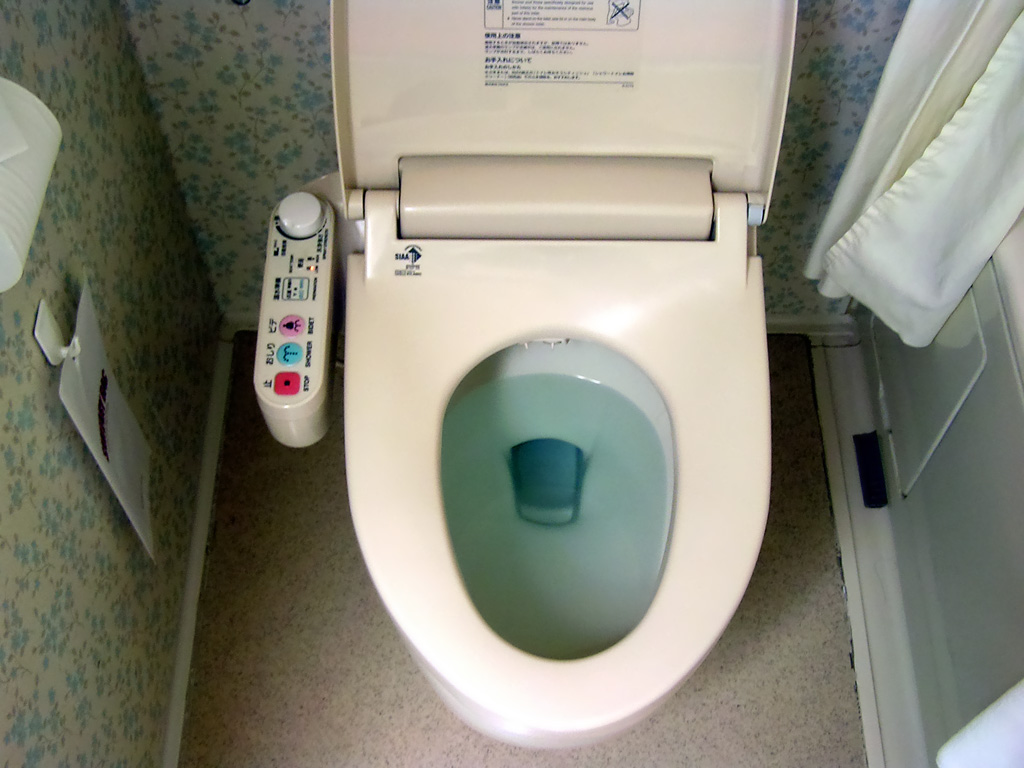![Image: By Armin Kübelbeck (own picture --Kuebi 20:29, 3 February 2007 (UTC)) [GFDL (http://www.gnu.org/copyleft/fdl.html) or CC-BY-SA-3.0 (http://creativecommons.org/licenses/by-sa/3.0/)], via Wikimedia Commons](https://selfreliancecentral.com/wp-content/uploads/2017/02/japanese-toilets-5-300x225.jpg)
After World War II, and the American occupation, modern Western-type flush toilets and urinals became common.
But then the Japanese love of technology took over. I couldn’t believe the toilet in my hotel room. It is a computerized tribute to the shining tush! It’s called a shower or bidet toilet and it squooshes all your nether regions with warm water, blow dries them and sometimes powders you as well. All on a warmed seat!
These types of toilets were, as of March 2016, installed in 81.2% of Japanese households.
![Image: By 浪速丹治 (Own work) [CC BY-SA 4.0 (http://creativecommons.org/licenses/by-sa/4.0)], via Wikimedia Commons](https://selfreliancecentral.com/wp-content/uploads/2017/02/C75-MK7-225x300.jpg)
A squat toilet essentially looks like a miniature urinal set horizontally into the floor. Most squat toilets in Japan are made of porcelain, although in some cases (as on trains) stainless steel is used instead. The user squats over the toilet, facing the hemispherical hood, i.e., the wall in the back of the toilet in the picture seen on the right. A shallow trough collects the waste, instead of a large water-filled bowl as in a Western toilet. All other fixtures, such as the water tank, piping, and flushing mechanism, may be identical to those of a Western toilet. Flushing causes water to push the waste matter from the trough into a collecting reservoir which is then emptied, with the waste carried off into the sewer system. The flush is often operated in the same manner as a Western toilet, though some have pull handles or pedals instead. Many Japanese toilets have two kinds of flush: “small” (小) and “large” (大). The difference is in the amount of water used. The former is for urine (in Japanese, literally “small excretion”) and the latter for feces (“large excretion”). The lever is often pushed to the “small” setting to provide a continuous covering noise for privacy, as discussed below.
Two variations are common: one where the toilet is level with the ground, and the other where it is raised on a platform approximately 30 cm (1 ft). The latter is easier to use for men to urinate while standing, but both types can be used for this purpose. There is also no difference for defecation or squatting urination. The user stands over the squat toilet facing the hood and pulls down (up in the case of skirts) their trousers and underwear to the knees. The user then squats over the hole, as close to the front as possible, as excrement tends to fall onto the rear edge of the in-floor receptacle if the user squats too far back; for this reason many public squat toilets have signs reminding the user to “Please take one step closer.”
Beginners and foreigners often hold onto the piping at the front, which therefore has earned the nickname “grunt bar,” from the sounds made while holding onto this pipe!
